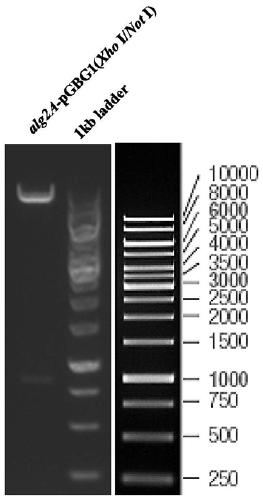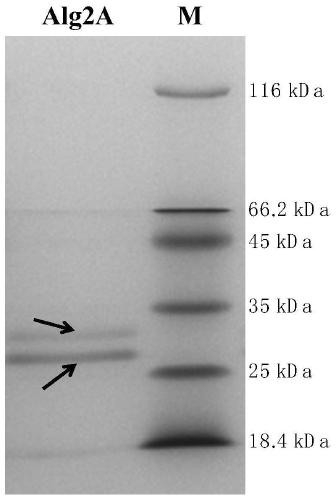Alginate lyase Alg2A and preparation method and application thereof
A technology of alginate lyase and alginic acid, applied in lyase, botany equipment and methods, biochemical equipment and methods, etc., can solve the unstable expression of free plasmid vectors, environmental pollution of resistance genes, increased difficulty, etc. problems, to achieve efficient and rapid hydrolysis activity, stable expression, and avoid pollution
- Summary
- Abstract
- Description
- Claims
- Application Information
AI Technical Summary
Problems solved by technology
Method used
Image
Examples
Embodiment 1
[0023] Example 1 Codon optimization and total gene synthesis of alginate lyase gene
[0024] On the premise of not changing the amino acid sequence, the codons of the gene encoding alginate lyase derived from Flavobacterium sp.S20 (Flavobacteriumsp.S20) were optimized. See SEQ ID NO.2. The identity (identity) of the optimized gene sequence and the original sequence of alginate lyase Alg2A (as shown in sequence SEQ ID NO.3, GenBank accession number: JF412659) is 77%. At the same time, in order to enable efficient and stable secretion and expression of alginate lyase in Pichia pastoris, the optimized alginate lyase gene lacks 22 amino acids encoding the 5' terminal signal peptide sequence. The optimized gene sequence was entrusted to Beijing Qingke Xingye Biotechnology Co., Ltd. for the total synthesis, and the synthesized gene sequence was recorded as alg2A.
Embodiment 2
[0025] Example 2 Construction of expression vector of alginate lyase gene alg2A
[0026] First, use restriction endonucleases Xho I and Not I to double-enzyme digest the cloning vector containing the alginate lyase gene alg2A to obtain the target gene fragment, and use the same endonuclease to double-enzyme digest the expression vector pGBG1, recover large fragments. The two recovered products were connected to obtain a recombinant vector named alg2A-pGBG1. In order to confirm that the target alginate lyase gene has been constructed into the vector, the recombinant vector was double digested with Xho I and Not I, and the product was subjected to agarose gel electrophoresis. The results are as follows: figure 1 shown. according to figure 1 It can be seen that after double digestion, the target gene fragment appeared between 750bp and 1000bp, which was consistent with the fragment length of alg2A of 834bp.
Embodiment 3
[0027] Example 3 Screening of alginate lyase Pichia pastoris engineering bacteria and preparation of alginate lyase
[0028] After the obtained recombinant plasmid alg2A-pGBG1 was linearized by the restriction endonuclease BglII, it was separated by gel electrophoresis and the large nucleic acid fragment containing the target gene was cut out. Recombinant colonies were obtained by screening. Eight of the colonies were picked and streaked onto a BMMY agar plate containing 0.2% sodium alginate, cultured at 30°C for 48 hours, then poured into 10% cetylpyridinium chloride (Cetylpyridinium chloride, CPC) aqueous solution for color development, and found Among them, No. 2, 5, 6 and 7 clone strains showed alginate cracking activity, see figure 2 , is the primary screening chart for the enzymatic activity of the recombinant expression Pichia pastoris GS115 strain sodium alginate substrate plate. A single colony of strain No. 6 was picked, inoculated in 50ml of BMGY medium, cultured...
PUM
 Login to View More
Login to View More Abstract
Description
Claims
Application Information
 Login to View More
Login to View More - R&D
- Intellectual Property
- Life Sciences
- Materials
- Tech Scout
- Unparalleled Data Quality
- Higher Quality Content
- 60% Fewer Hallucinations
Browse by: Latest US Patents, China's latest patents, Technical Efficacy Thesaurus, Application Domain, Technology Topic, Popular Technical Reports.
© 2025 PatSnap. All rights reserved.Legal|Privacy policy|Modern Slavery Act Transparency Statement|Sitemap|About US| Contact US: help@patsnap.com



